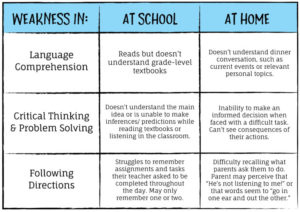
When a child has an identified comprehension weakness, it makes sense to pursue extra help for academics. Students can get help from tutors, learning specialists, or may have an IEP (Individualised Education Plan) in place at school. Unfortunately, language comprehension troubles can affect family life, too. This is especially difficult when weak thinking skills are misconstrued as poor behavior. The child who “never listens” may not understand the task at hand.
A primary cause of language comprehension problems is difficulty creating mental images for language. This weakness causes individuals to get only “parts” of information they read or hear, but not the whole. This weakness often undermines the reading and thinking process. Students with weak language comprehension are commonly saddled with the misconception that they are just not trying, or, that they are distractible. In fact, they may be trying very hard to memorise everything they have heard or read. And they need help.
Check out some examples of how concept imagery issues can affect school and home:

The imagery-language connection is key to good thinking and communication. You can help address comprehension in the following ways:
1. In conversation
During discussions with your child about their day or current events in the news, use imagery-stimulating questions. For example, instead of asking, “What do you think about…?” you can ask, “What did you picture for that story in the news today?” or “What are you picturing for what might happen next?” You can expand upon these questions to dive into their images even more.
2. When reading together
After you or your child reads aloud or listen to a story together, you can gauge comprehension by asking some imagery questions. “How did you see that happening?” or “What do you picture happening next?” can begin a fun discussion of the story and allow you to see what your child is getting out of it.
3. When there’s a problem to solve
Help your child target specific images they’re creating while they’re processing oral or written language. Teach them to continually ask themselves whether they understand what the consequences may be of certain actions, and if they’re able to picture the outcome: “If I do this, what might happen? What does that look like?”
4. When you give instructions
Establish an imagery-language connection through daily life activities to stimulate learning. For example, when giving your child instructions, such as brushing their teeth, getting dressed, or making their bed, ask your child to picture these tasks in their mind before they do them.
5. When learning something new
Whether your child is learning the rules of Monopoly for the first time or helping you get through a favourite cookie recipe, prompting your child to visualise the language is a great start. You can also fall back on the imagery-language connection to check for understanding and to answer questions. For example, “What do you see for ‘bankrupt’?”
Comprehension Solutions at Lindamood-Bell
The imagery-language connection can be developed as a foundation for comprehension and thinking. Students can make years of growth in just a few weeks.
An accurate learning ability evaluation is the first step toward helping your child learn to their potential. We uncover the strengths and weaknesses that are affecting comprehension, and in a thorough results consultation, we will discuss a learning plan to change learning in the shortest time possible. Recommendations are differentiated based on the unique learning needs of each student.
Contact us to learn more or get started: Double Bay and Brisbane (02) 9328 7119 | Chatswood and Melbourne (02) 9410 1006





